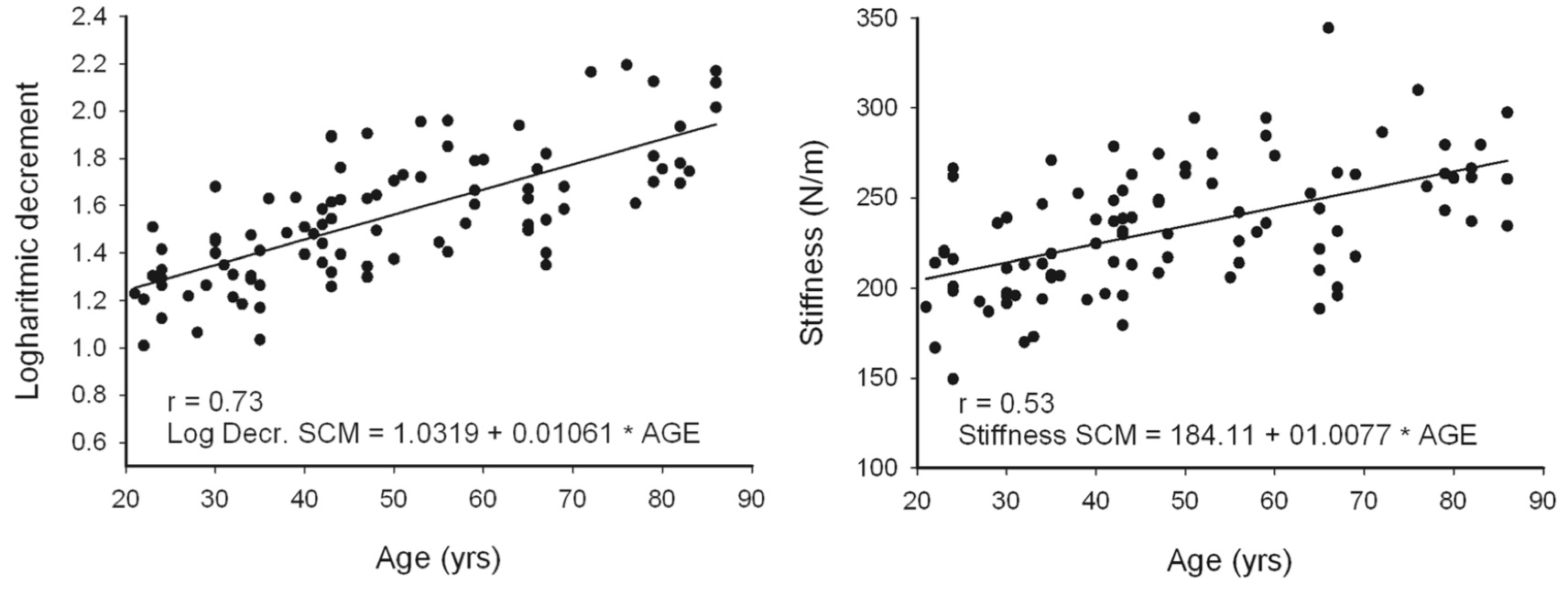Publications

Relationship between age, BMI, head posture and superficial neck muscle stiffness and elasticity in adult women
Authors: Piotr Kocur, Maciej Tomczak, Marzena Wiernicka, Magdalena Goliwąs, Jacek Lewandowski, Dawid Łochyński
Affiliations: Poznan University of Physical education, Department of Musculoskeletal Rehabilitation and Department of Psychology, Poznan, Poland
Journal: Nature - Scientific Reports - June 2019, Volume 9, Article no. 8515 (DOI: 10.1038/s41598-019-44837-5)
-
Field & Applications:
- Medical
- Women's health
- Gerontology / Ageing
- Muscle development / Performance
- Musculoskeletal rehabilitation
- Validity
Background
Aging results in progressive changes in the structure and function of the neuromuscular system that limits physical performance and leads to disability, decreased autonomy and quality of life. Skin, subcutaneous, myofascial and skeletal muscle tissue undergoes substantial remodelling with aging.
With aging the degenerative changes in the connective tissue lead to decrease in elasticity of integumentary and musculoskeletal system and to increase in muscle stiffness.
Myofascial stiffness is one of the essential indicators of energy storage of muscle-tendon unit, and can affect control of joint motion. In recent years, the biomechanical parameters reflecting adaptive changes in viscoelastic and mechanical properties of various skeletal muscles have been increasingly studied.
Up to date significant differences in muscle stiffness parameters were found between the elderly and young individuals using sonoelastography or MRI.
Furthermore, using myotonometry device “MyotonPRO”, a reliable and reproducible non-invasive measurement method, higher stiffness values and lower elasticity of superficial muscles of neck and face were found in old individuals compared to young ones. However, it is not known how these mechanical properties of neck muscles change between third and ninth decade of life, and whether they are affected by other factors such as body fat or head posture.
The aim of the study was to determine the relationship between age, BMI, and position of head, and stiffness and elasticity of the SCM and upper trapezius (UT) muscles in adult women. These superficial neck muscles have been chosen since they demonstrate lower susceptibility to atrophy and relatively unchanged pattern of activity across life compared to limb muscles. So far, no attempt has been made to determine changes in biomechanical parameters of superficial neck muscles with aging, while their alterations could become an important predictor of biological age. As BMI, forward head posture and muscle stiffness have been shown to be increased and muscle elasticity to be decreased in old individuals, we hypothesized that this process would start in the early adulthood and continue with age. We also tested the hypothesis that age will be the strongest predictor affecting neck muscle mechanical parameters.
Practical consideration
The important practical aspect of our study is that the elasticity of the SCM, measured at the specific location of over the muscle belly, can become a biomarker for physical state of skeletal muscles and may serve in the future as a simple estimator of the body biological age.
Moreover, although the degenerative changes in the myofascial tissue are irreversible and progress with time, the effects of aging can be delayed and muscle function improved. The passive elastic stiffness of very inactive and sedentary people may be different from the active women. It is known that a minimal level of physical activity may prevent the accumulation of connective tissue in the aged muscles. In future, assessment of stiffness and elasticity of the SCM and UT muscles could provide important knowledge for evaluation and programming of specific therapeutic interventions directed to improve muscle function in the neck region.

With aging, elasticity decreases and stiffness increases in the SCM and UT muscles approximately 1.5% per year between the third and ninth decade of women’s life.
Aging affects mechanical properties (especially elasticity) more strongly in the SCM than UT muscle.
BMI increases with aging but this weakly explains the difference in mechanical properties of the superficial neck muscles during the adult life in women. Although anterior positioning of head increases with age, it does not account for the variance in the superficial neck muscle mechanical properties with aging.
Additionally, it should be underscored that the large proportion in the variance of mechanical parameters of superficial neck muscles is not explained and thus presumably not affected by the processes directly related with aging. This suggest that other factors, such as anatomical differences in structure and composition, or habitual daily activity and loading of neck myofascial tissue, presumably account for variance in the superficial neck muscles stiffness and elasticity during sitting among women.


